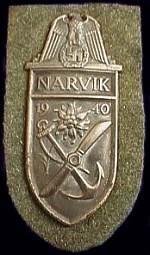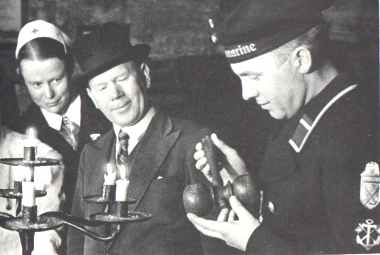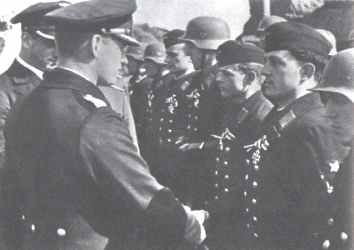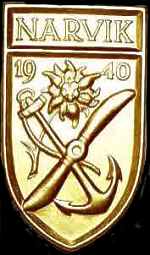
By Sebastián Bianchi
The Narvik Shield, designed by Professor Klein of Munich, was
instituted on the 19th of August 1940. It was authorized for all
German forces that took part in the conquest and subsequent defense of the
port city of Narvik during the Norway Campaign. The battle took
place between the 9th of April and the 9th of June 1940. The allies
withdrew on June 9th due to the unfavorable turn the campaign in France,
that started on May 10th, had taken. There was particularly heavy
land fighting and naval engagements in the port, with the German garrison
being brought to the brink of disaster before the Allied withdrawal.
Shield Properties
The award takes the form of a shield that is surmounted by
an eagle with elongated wings, clutching in its claws a wreath that
surrounds a swastika. Under the eagle there are 3 lines, with the last one
constituting the top of the box that encloses the word “NARVIK”. The
main body of the shield was designed to represent the three branches that
were responsible for the success of the campaign. It features an edelweiss,
representing the mountain troops of Generaloberst
Edward Dietl, an anchor, representing Kommodore Bonte’s Destroyers,
and a propeller, which pays tribute to the Luftwaffe units (both air and
field) which participated in the battle. The anchor and propeller are
crossed, and the edelweiss fits between them on the top portion of the X,
with the numbers “19” and “40” placed at the top corner of the main
body of the shield.
 |
 |
| Narvik Shield | Kriegsmarine Maat wearing the Narvik Shield as regulated. |
The award was hollow backed and stamped from sheet metal which was usually zinc, although a few early examples were made in brass. Depending on the class, the shield was painted gold or silver, and in this respect it is unique among shields as no other was produced in two versions. T he silver class went to the Luftwaffe and Heer, while the gold was presented to Kriegsmarine members. The cloth back of the shield matched the color of the service the recipient belonged to.
The shield was worn on the left arm of the uniform as
described above. Each recipient was presented with 3 copies, and had
the ability to purchase additional copies by producing the award document.
Criteria and Award Statistics
As already mentioned, the Shield was presented to those who participated in the battle of Narvik. In the case of death, the award was presented posthumously to the next of kin.
The first award was made to Generaloberst Edward Dietl by Hitler on March 21st, 1941. A total of 8,577 shields were presented, and they were distributed in the following manner:

Kriegsmarine members are awarded the
Iron Cross for Service in Narvik
Heer
Total- 2,755
2. Gerbigs-Division - 206
3. Gerbigs-Division – 2338.
Posthumous-96
Luftwaffe Total – 2,161
Flying Crew – 1,309
Paratroopers-756
Posthumous – 410
Kriegsmarine – 3,661
Destroyer Crews- 2,672
Other – 115
Posthumous – 410
Merchant Navy- 442
Merchant Navy Posthumous-22
Narvik Shield 1957
In 1957, the Shield was reissued in the same manner without
the eagle and swastika. The regulations remained basically the same, with
the only difference being that now junior NCO’s and privates were allowed
to wear the shield on their white shirts and dress jackets.
 |
|
Narvik Shield 1957 |
![]()
© Copyright Wehrmacht-Awards.com LLC |